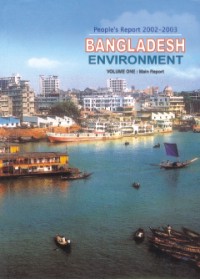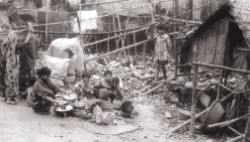Environment
 People's
Report on People's
Report on
Bangladesh
Environment
Elita
Karim
What
is unique about 'The People's Report on Bangladesh Environment'
is environmental issues from the viewpoint of the people affected
by them and attempt at presenting its conscientious. This
edition focuses on the urban environment and covers a number
of issues related to urbanisation, namely, poverty, population,
health and nutrition, industrialisation, energy and the like.
Issues such as land and agriculture, forestry and biodiversity,
water and climate have also been taken into account.
This report
consists of two volumes; Volume I exposes people's perception,
views, survey outcomes and expert's opinions on environmental
issues, developmental policies and directions. It emphasises
on the individual aspects of industry, water, land and agriculture,
fisheries and livestock, forestry and biodiversity and climate
and also their effects on the environment. Volume II provides
corresponding database on the many different aspects of Bangladesh
environment.
 Published
by the Unnayan Shamannay under the Sustainable Environment
Management Programme (SEMP), this publication was supported
by the Ministry of Environment and Forest (MoEF) and the United
Nations Development Programme (UNDP). Published
by the Unnayan Shamannay under the Sustainable Environment
Management Programme (SEMP), this publication was supported
by the Ministry of Environment and Forest (MoEF) and the United
Nations Development Programme (UNDP).
One might
wonder about the reason behind the Urban Focus. Clearly, urbanisation
is a predominant aspect of contemporary life. People of a
varied background and occupation live in urban areas, although
perhaps the middle-income group represents the mainstream
population.
Despite
the over crowding, traffic jam, smog and noise, people prefer
to live in urban areas. Some have even moved from the village
homes and built permanent homes in the city. Urban residents
experience the environment in a variety of different ways
depending on their occupation and where they live. Therefore,
their perception about the environment may vary on the basis
of their everyday experience. Some, in the urban areas, are
lucky enough to experience and enjoy public water supply,
mass transit, shopping malls and amusement parks.
Poverty
exacerbated by over population is a major factor in the weakening
of the ready assets and also the man-made resources that a
society can provide.
Poverty
in Bangladesh is expected to grow with rapid urbanisation.
The growth of the urban poor in number means that excessive
pressure will be applied on the limited utilities present,
which would only complicate further the vicious circle of
poverty and environmental degradation.
According
to Federico Mayor and Jerome Binde, the urban population world-wide
is currently growing two to three times more rapidly than
the rural population (The World Ahead: Our Future is the Making,
Zed Books/UNESCO, 2001). It has been estimated that four billion
people will be living in urban areas in the couth comprising
about 57 percent of its total population. Therefore, according
to the report, management of urban environment is probably
a necessity, which also has a global context. The report further
talks about the environmental problems that intesifies urban
poverty. For instance, the poor are being forced to live in
environmentally unsafe areas, like flood plains, polluted
sites near solid waste dumps, open drains, sewers and around
polluting industries. Because the urban poor suffer from insecurity,
overcrowding, inadequate sanitation and water facilities,
various kinds of violence and changes in the labour market,
the interlink between environmental degradation and poverty
is more pronounced in urban areas than the rural areas.
 According
to some experts mentioned in the report, there is a growing
need to reinvent cities. Dhaka, according to them, is not
yet a city. "It is only a gigantic, bursting agglomerate
of building, bazaars (markets) and glorified bastees (slums)." According
to some experts mentioned in the report, there is a growing
need to reinvent cities. Dhaka, according to them, is not
yet a city. "It is only a gigantic, bursting agglomerate
of building, bazaars (markets) and glorified bastees (slums)."
A solution
suggested by the report is regaining public space for all
citizens. Major importance has been given to the many necessities
of people to lead a decent life in the urban environment,
namely health care, safe water, employment opportunities,
a roof over people's heads, no threat of eviction, security,
education, sanitary latrine, gas and electricity.
A huge
number of issues have been discussed, starting from the provision
of legal settlements to homeless people, eradicating the illegal
settlements, to the provision of safe drinking water, security,
health and medical facilities for everyone.
Copyright
(R) thedailystar.net 2005
|
